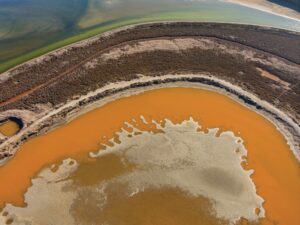Some people call Bair Island Redwood City’s front yard. Others recall it as a domino that didn’t fall to urban development that spread down the Peninsula. Now it’s home to one of the largest marsh restoration projects on San Francisco Bay, where volunteers and an unusual work group help renew a wildlife oasis surrounded by housing, an airport, a freeway, and a deepwater port.
“Bair Island is special because it has really good clapper rail habitat now,” says Eric Mruz, wildlife refuge specialist for Don Edwards San Francisco Bay National Wildlife Refuge, which manages the area. Both the California clapper rail and salt marsh harvest mouse, listed as endangered in 1970, find homes on 2,600-acre Bair Island, which is actually three islands–Inner, Middle, and Outer Bair–separated by winding sloughs. Harbor seals pup here, and numerous shorebirds use the area too.
Outer and Middle Bair provide refuge for wildlife, and there’s no public access, but Save the Bay staffers guide frequent canoe trips to Middle Bair, where volunteers help restore habitat. “It’s a special place, and our volunteers really get a feeling for that,” says Laura Wainer, restoration projects manager for Save the Bay. Over three years, about 1,000 volunteers have pulled up tens of thousands of pounds of iceplant and other non-natives and planted nearly 3,000 salt marsh natives, such as gum plant, salt grass, and alkalai heath. Volunteers assist with fall and winter planting, spring weeding, summer watering, and fall seed collection.
Bair was long ago diked for agriculture, then used for salt production until the mid-1960s. Meanwhile, nearby wetlands disappeared under developments in Foster City, then Redwood Shores. Bair Island was next in line, but Redwood City voters halted development plans in a 1982 referendum. It was finally protected in 1997 when the Peninsula Open Space Trust purchased the majority of it, later transferring it to state and federal wildlife agencies, which had also acquired portions of the island.
The 1,400-acre restoration involves all three parts of Bair. Easternmost Outer Bair has been restoring itself since the 1970s, when levee maintenance ceased, some levees failed, and bay waters flowed in. The final levee breaches, planned for this fall, will be made near historic channels to maximize tidal flushing.
Inner Bair is closed to the public for a few years as workers use heavy equipment to deposit up to one million cubic yards of dirt where the island has subsided. “It’s at least two feet below what’s needed for bay sediments to fill it in enough to start growing marsh plants,” says Mendel Stewart, San Francisco Bay National Wildlife Refuge Complex manager.
- A student volunteer from the Marine Sciences Institute pulls nonnative iceplant with Save the Bay’s Canoes in Sloughs program. Photo by Jessica Castelli/Save the Bay
Thanks to the Bair Island Task Force, some of that fill will come from the neighboring Port of Redwood City, in a model of beneficial reuse of dredge materials. This atypical group focuses on the nitty-gritty of restoration. “They’ve been a big asset,” Stewart says. Participants include the port, the U.S. Fish and Wildlife Service, the Army Corps of Engi- neers, Redwood City, the Bay Planning Coalition, Save the Bay, and Ducks Unlimited.
Different interests bring everyone to the table, says Felicia Madsen of Save the Bay, “but we all share the common goal of restoring Bair Island.”
Salt marsh denizens won’t be the only beneficiaries. Eventually, a refurbished, restroom-equipped parking lot will serve an estimated 250,000 visitors each year. They’ll rediscover Inner Bair on a new trail with wildlife observation platforms and interpretive signs.
Even as Bair is reborn, public focus has shifted to tensions over recently retired salt ponds to the south. The 1999 Baylands Ecosystem Habitat Goals report envisions 100,000 acres of tidal wetlands; a quarter of that remains to be acquired. Restoring this 1,433-acre parcel would help reach the goal. Owner Cargill Salt, however, prefers more lucrative housing. No development plans have been submitted, but this fall Redwood City voters face competing measures targeted at this next domino.
As Bair’s story reminds us, stopping development is only the first step toward recreating thriving tidal wetlands. Here, cooperation and the pull of a shared vision are getting the job done.
For updates, visit www.redwoodcity.org/bair. Visit www.savesfbay.org/bairisland to sign up for restoration trips.

.jpg)




